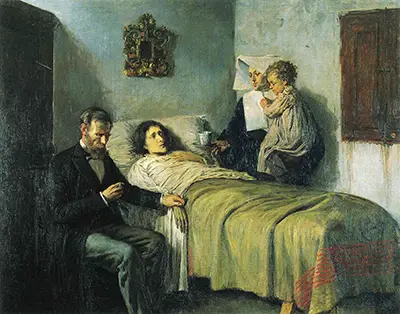It was also in the wake of the death of another one of his sisters from diphtheria. The other disease themed paintings are; The Sick Woman (1894) and Last Moments (1899). It was a period in which the field of science was full of promise in altering the course of diseases. With all this promise, science had become the centre of attention in the eyes of the public and Picasso. The death of his sister to diphtheria was especially painful to Picasso. This was because even though the antitoxin was available to wealthy rich families, it could not be secured in time to save his sister. Picasso's family could also not afford their daughter a decent burial. This inspired Picasso to pursue art as a way to make a statement. This is evidenced in one of his later inscriptions on a later print, "At the end of the road death waits for everyone, even though the rich go in carriages and the poor on foot."
Picasso's Science and Charity depicts an authoritative and unemotional medical professional against a tender and compassionate nun. The patient is in the middle of these two contrasting figures. While the doctor is examining the health of the patient by monitoring his pulse, the nun on the hand is offering emotional reassurances to the patient’s family. This was a time when there were few or no effective treatments available, thereby elevating the professional status of the physician to greater heights. Picasso gave the painting to his physician uncle, who perceived it as an homage paid to him. After producing this painting, Picasso's family pooled their resources together in a bid to enable him go for further education in Madrid.
It was while in Madrid that his artistic influences increased dramatically. Picasso's talent meant that he soon abandoned academic techniques and started delving in pioneering contemporary methods such as cubism, printmaking and ceramics among others, for which he is so closely identified. Asides from being a skilled draftsman with supreme mastery of skill and technique, Picasso also recognized the power of using symbolism and metaphors to stimulate the imagination of his audience. This is evident when he skilfully uses the metaphorical distance between the physician and the patient. This distance between the authority and the afflicted provoked debate in the medical setup throughout the 20th century. It was a debate which called for the physician to balance authority and compassion.
Pablo Picasso (1881-1973), is one of the few revered artists of his time known for his unsurpassed mastery of skill and technique. Known as Pablito by his family, he was born in the Mediterranean harbour of Malaga, Spain. He was brought up by an unoriginal painter father, and an optimistic and good humoured mother. Picasso had a difficult birth and nearly died. Those close to him attest that he began drawing even before he could speak. It was not long that Picasso’s drawing ability surpassed those of his father and later his art school contemporaries, many of whom were his seniors and even a decade older. Picasso in his early years was mostly influenced by physicians. This likely played a major role in the choices he made regarding his early subjects. His paternal uncle was a respected physician and would finance both his father's as well as his own training. Picasso enrolled in an art institution at the Instituto da Guarda while aged 10. The director of this art school also happened to be a physician. He recognized Picasso’s unmatched abilities and became his mentor and patron. He became the first one to commission and buy Picasso’s work.

